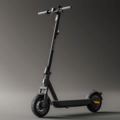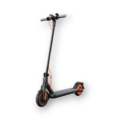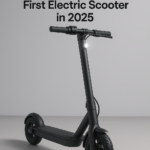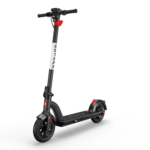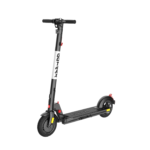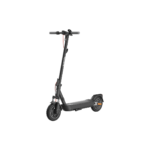- Home
- Scooters
- Electric Scooters
- Xiaomi Electric Scooter 4 Pro Plus
Xiaomi Electric Scooter 4 Pro Plus
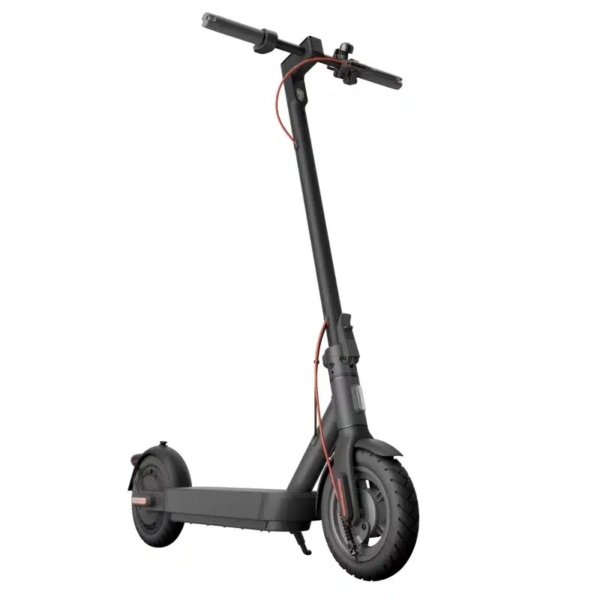

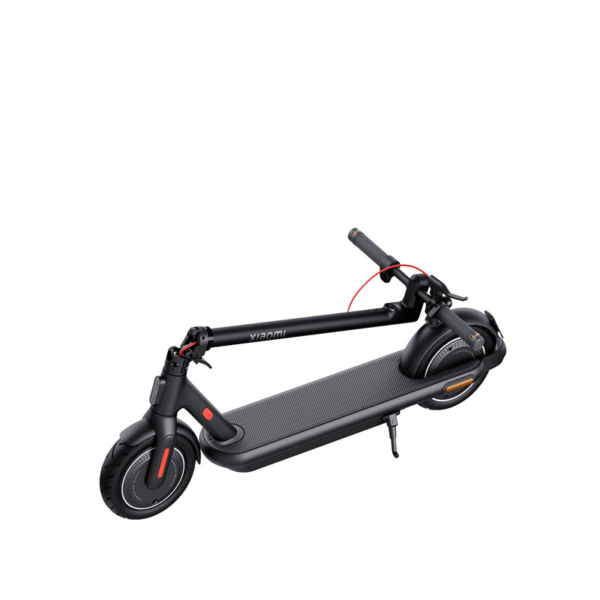

- Battery Range: 60 km
- Top Speed: 25 km/h
- Motor Power: 350 W rated
- Weight Capacity: 120 kg (265 lb)
- Charging Time: 3 hours
- Scooter Weight & Portability: 19.5 kg (43.0 lb)
PROS
- Run-flat 10″ tires reduce puncture risk and add real-world compliance
- Rear-wheel drive traction with calm, progressive throttle and regen
- Steel frame and sturdy 3-step fold keep rides quiet over time
- App features that matter: remaining mileage, KERS tuning, auto-light, lock
- Integrated turn indicators and brighter taillight enhance visibility
CONS
- 25 km/h cap may feel limiting to speed-seekers
- 19.5 kg weight is solid; frequent stair carries will be noticeable
- No suspension; comfort relies on tire compliance and pace
Introduction: Xiaomi’s Calm, Long-Range Commuter With Real-World Smarts
The Xiaomi Electric Scooter 4 Pro Plus Specifications reveal a commuter that favors consistency, comfort, and control over attention-grabbing numbers. Yes, it posts solid figures—960 W max power, 20% climbs, and a 60 km headline range—but the real story is how these parts work together. The frame is steel-strong yet tidy; the 10-inch run-flat tires shrug off punctures; and the rear-wheel drive delivers steady traction at everyday speeds. Meanwhile, the app adds practical, low-friction tools: energy-recovery tuning, a simple lock, remaining mileage, and a new auto-light mode. As a result, daily rides feel repeatable and low-stress.
Moreover, Xiaomi keeps the cockpit clean. A single function button handles power, lights, and modes; the dash stays legible at a glance; and integrated turn indicators remove the usual handlebar clutter. Consequently, you spend less time fiddling and more time looking ahead. This alignment—calm hardware plus focused software—defines the 4 Pro Plus. It is a scooter for habitual commuting, not for weekend stunts.
Motor & Drive: Predictable Thrust, Confident Traction
Power delivery shapes confidence. Here, a 350 W rated motor peaks up to 960 W, then routes that torque through the rear wheel. Because rear-drive pushes rather than pulls, the front end tracks cleanly over gritty paint lines and broken patches. You tip in, roll on, and the scooter holds its line without the faint tug you sometimes feel on front-drive models. Therefore, starts feel steady, lane changes feel deliberate, and mid-corner corrections feel natural rather than twitchy.
Acceleration remains measured rather than explosive, which suits real city riding. In Standard mode, the scooter builds pace smoothly to 20 km/h, conserving battery while keeping a calm cadence among bikes. In Sport, it edges to 25 km/h and stays there without drama. In fact, that cap helps the chassis remain composed over expansion joints and pavers. Because the deck and stem don’t have to quell 30-plus km/h chatter, they simply ride quiet.
Hills tell the same story. The 4 Pro Plus handles 20% neighborhood climbs without stalling, yet it does so with a steady push instead of a sudden surge. That temperament keeps you in control on narrow lanes and gives you room to pick clean lines around storm grates or cracks. For daily routes that roll and bend, this balance between output and grip beats a spec-sheet sprint.
Speed & Flow: Why 25 km/h Works Better Than It Looks
Plenty of riders say they want more speed; few use it daily. City flow rewards predictability more than peak velocity. At 25 km/h, you slot into bike lanes, cross short gaps with time to spare, and retain headroom for quick stops. Because the scooter does not chase extreme speed, it can tune throttle and regen to feel progressive. You nudge the lever, it rolls; you ease off, it slows with mild engine-brake feel; you squeeze the lever, the mechanical system joins in. Consequently, the scooter signals every change to other road users: gradual speed up, gradual slow, then a firm stop.
Furthermore, sensible pace reduces fatigue. At 25 km/h on a rigid, non-suspended scooter, bumps arrive as brief pulses rather than harsh hits. The 10-inch run-flat tires blunt those pulses, and the steel frame damps the rest. You arrive without numb hands, which means better control and safer decisions as the day wears on.
Braking & Stability: Dual Systems, One Smooth Stop
Safe braking isn’t only about raw force. It’s also about sequence. The 4 Pro Plus starts with electronic anti-lock braking on the rear wheel, then layers in a mechanical brake at the front (Xiaomi’s spec pages shorthand this as E-ABS + drum). In practice, you feel a gentle deceleration first, which transfers weight forward without a jolt. As your lever travel increases, the mechanical system adds bite and shortens the stop. Because the onset is progressive, the chassis stays settled and the contact patches remain planted.
Equally important, the run-flat 10-inch tires keep rolling even after a puncture, which helps you retain control long enough to pull off safely. While you shouldn’t ride on a flat for long, the ability to maintain steering and brake to a stop after a loss of air is a quiet safety net.
Finally, high-visibility hardware supports safe braking behavior. The bigger taillight brightens under brake, integrated direction indicators warn others early, and auto-light mode removes one more task at dusk. Together, these details turn a routine stop into a predictable cue for everyone around you.
Battery & Range: Built for Routine, Tuned for Longevity
Range needs to feel repeatable. The Xiaomi Electric Scooter 4 Pro Plus Specifications target a 60 km headline under defined conditions, and—more importantly—the pack pairs with adjustable energy recovery so you can tailor glide versus regen. On rolling routes, a higher KERS setting gives a mild engine-brake feel that reclaims a bit of charge while smoothing your pacing toward lights and crossings. On flat paths, a gentler setting lets you coast and carry speed.
Charging fits daily life as well. The standard charger tops the pack in about nine hours, which aligns with overnight routines. If you add Xiaomi’s Fast Charger, you can refill in roughly three hours, which rescues late starts or double-errand days. Because the battery management system guards cell health with temperature and current protections, you can focus on simple habits: avoid chronic deep discharges, store indoors, and top up after rides rather than letting it sit empty.
Critically, Xiaomi’s app exposes remaining mileage in straightforward terms. You glance at the number and decide whether to take the long way or the shortcut. Over a few weeks, you learn your own range curve by season and route, which removes the last bit of uncertainty from daily travel.
Tires & Ride Feel: Run-Flat Peace of Mind With Real Compliance
Punctures don’t just waste time; they ruin momentum. The run-flat 10-inch tires solve that practically. Internally reinforced and engineered to keep shape, they resist typical urban punctures and, if deflated, retain enough structure to let you roll safely to the curb. Just as important, they ride better than older solid designs. Their volume and construction give noticeable compliance over seams and pavers. You still feel the road—this is a scooter, not a sofa—but you feel less sting and less chatter.
Consequently, you can ride longer without hand fatigue. Your elbows relax, your shoulders drop, and your line choice becomes smoother. That same calm keeps small mistakes from cascading: hit a shallow crack at an angle, and the tire rounds it rather than slapping it. For commuters who ride day in and day out, the combination of no puncture drama and enough comfort eclipses the marginal gains of a lighter but more fragile tire.
Frame, Fold & Fit: Steel Backbone, Quiet Joints, Compact Stow
The 4 Pro Plus uses an automotive-grade steel frame for a reason: steel allows slim sections with serious strength, and it damps vibration in a way many aluminum frames do not. The result is a scooter that feels planted at speed and quiet over time. You don’t chase mystery squeaks from flexy hinges because the 3-step folding latch closes with a positive, repeatable feel.
Unfolded, the scooter stands 1221 mm tall with a 523 mm bar width—roomy for leverage yet narrow enough for tight corridors. Folded, it drops to 1179 × 523 × 506 mm, which slips easily into hatchbacks, under office desks, or next to a café table. Because wiring is routed cleanly and the kickstand is placed sensibly, parking feels natural whether you tuck the scooter against a wall or stage it near a doorway.
At 19.5 kg, it’s solid rather than featherlight. Even so, the balance point sits near the stem, so lifting the front to pivot in tight spaces feels natural. If you carry the scooter often up several flights, you’ll notice the weight; if you only lift for a curb or a trunk, it feels entirely manageable.
Cockpit & Lights: Fewer Buttons, More Focus
Simplicity keeps your eyes up. The multifunction display shows speed, battery, and status without clutter. The single function button switches modes and toggles lighting; the indicator button sits where you can reach it without shifting your grip. Because you don’t dig through menus, you maintain situational awareness—the key to riding safely among bikes, cars, and pedestrians.
Auto-light mode adds a small but welcome luxury. At dusk, the headlamp comes on without a second thought; on bright mornings, it stays off. Meanwhile, the larger taillight burns steady when the headlight is on and brightens under braking, which frames your slow-downs clearly for those behind you. For a commuter that often runs in mixed light, these cues matter.
App Features: Tools You’ll Actually Use
Xiaomi’s Mi Home / Xiaomi Home app keeps only the essentials. You open it, and you see lock status, remaining mileage, battery level, and connection settings. You can toggle auto-light, apply firmware updates, and select energy-recovery intensity. That’s it. No noise, no gimmicks. Because the app stays this focused, you set it once, check it occasionally, and ride.
Furthermore, the motor lock deters casual roll-aways at cafés or shops. It’s not a substitute for a proper lock, yet it buys time and—paired with smart parking choices—makes opportunistic theft much less likely. For everyday errands, that peace of mind is worth more than another buried setting.
Daily Scenarios: Where the 4 Pro Plus Shines
Cross-town commutes (8–12 km round trips). You leave on Standard mode, slip into Sport for a riverfront stretch, and let gentle regen handle most slow-downs. You arrive with battery to spare and without a chorus of rattles.
Errand chains with detours. The app’s remaining mileage keeps expectations honest. If a last-minute pickup appears, you raise KERS a notch and cruise a touch slower. The scooter remains calm; your schedule remains intact.
Wet-morning rides. IPX4 splash protection, cautious pace, and progressive braking keep the route low-drama. Run-flat tires shrug off the glass speck you didn’t see. You finish your coffee instead of fixing a tube.
Transit + ride. The 3-step fold helps you board without fuss. In a crowded car, the scooter’s compact 1179 × 523 × 506 mm footprint means you’re not that person blocking the aisle.
Maintenance & Ownership: Minimal Chores, Maximum Uptime
The 4 Pro Plus keeps upkeep light. Run-flat 10″ tires remove puncture anxiety and tube top-ups. The electronic brake eliminates pad swaps at the rear, and the front brake’s enclosed hardware stays consistent in dust and drizzle. Monthly fastener checks, a quick deck wipe, and sensible charging habits cover most of your routine.
Battery care stays simple. Avoid letting the pack sit empty, store indoors, and charge on a hard surface. If you adopt a “workday” top-up pattern rather than deep drains, you’ll see steadier performance through winter and longer overall pack life. Firmware updates, when offered, are one-tap affairs that improve behavior without shop visits.
Because the fold is robust and the frame is steel, the scooter tends to stay quiet as miles accumulate. If you do hear a rattle, it’s usually an accessory or a loose bolt—not a structural hinge. Fix it early, keep riding, and enjoy the bliss of a commuter that just works.
Comparisons & Fit in the Xiaomi Line
Inside Xiaomi’s lineup, the 4 Pro Plus sits above the Scooter 4 / 4 Lite in range and poise, and below the 4 Ultra in outright performance. Compared with the classic 4 Pro (2nd Gen), the Plus brings a stronger max output and a refined package that emphasizes run-flat tires, rear-drive traction, direction indicators, and a steel frame. If your routes stretch toward 15–20 km daily and you value low-maintenance comfort, the Plus makes more sense than the lighter, shorter-range models.
Against similarly priced rivals, the Plus wins on puncture resilience, ride quietness, and app polish. Many competitors either skimp on lighting and indicators or add flashy dashboards while neglecting folding rigidity. Xiaomi does the reverse: it sweats the boring details that make commuters better over months, not minutes.
Who It’s For (and Who Should Skip It)
Choose the 4 Pro Plus if you want a long-range, low-drama commuter that handles real streets, rolls through small debris without flats, and stays composed at 25 km/h. Daily riders, students crossing large campuses, and mixed-surface commuters fit this model perfectly.
Skip it if you demand faster than 25 km/h, need suspension for rough trails, or carry a scooter up several flights every day. In those cases, a lighter, shorter-range folder or a suspended performance model will suit you better—even if that means more maintenance and cost.
Final Verdict
Taken together, the Xiaomi Electric Scooter 4 Pro Plus Specifications describe a scooter that understands city life. It blends rear-wheel drive traction, a 60 km practical envelope, and run-flat 10″ tires with a steel backbone and quiet folding. Then it adds just enough software—KERS tuning, auto-light, motor lock, and remaining mileage—to remove friction from your day. It does not chase top-speed bravado; it chases repeatable, comfortable, low-maintenance rides. If that sounds like your week, this is the right tool.
Specifications
General
| Model The Model specifies the exact version or name of the scooter. It helps identify its unique design, features, and specifications within the manufacturer’s product line. Knowing the model makes it easier to compare options, find compatible accessories, or look up support information. | Electric Scooter 4 Pro Plus |
| Brand The Brand identifies the manufacturer or company that designs and produces the scooter. A trusted brand is a sign of quality, reliability, and good customer support. Well-known brands often have higher standards for safety, performance, and after-sales service, giving you more confidence in your purchase. | Xiaomi |
| Release Date The Release Date indicates when the scooter model was officially launched on the market. This helps you know how current the design, technology, and features are. A newer release date often means updated components, improved performance, and the latest safety or smart features. | 01 January 2024 |
| Recommended Age Recommended Age indicates the minimum age range that the scooter is designed for, based on safety, size, and ease of use. Following the recommended age helps ensure that riders can handle the scooter’s speed, weight, and controls comfortably and safely. Always check local laws and use protective gear, especially for younger riders. | 16–50 years |
Performance & Power
| Motor Power (Wattage) What it means: The motor power, measured in watts (W), shows how strong the scooter’s electric motor is. Why it matters: Higher wattage usually means better acceleration, more torque, and improved performance on hills or rough terrain. For example, a 250W motor is good for flat city roads and light riders, while a 500W or 1000W motor provides more power for faster speeds or climbing steep inclines. | 350 W rated, 960 W max |
| Top Speed The Top Speed indicates the maximum speed that the scooter can reach under optimal conditions. It’s usually measured on level ground with a fully charged battery and an average rider weight. A higher top speed allows you to travel longer distances faster, but always ensure you ride within legal speed limits and your personal comfort zone for safety. | 25 km/h (modes: Pedestrian 6 km/h, D 20 km/h, S 25 km/h; may vary by region) |
| Battery Capacity Battery Capacity refers to the total amount of energy the scooter’s battery can store, usually measured in ampere-hours (Ah) or watt-hours (Wh). A higher battery capacity means you can ride longer distances on a single charge, reducing the need for frequent recharging. Keep in mind that actual range can vary depending on rider weight, terrain, speed, and weather conditions. | 10.2 Ah pack (48 V-class system; charger max 54.6 V) |
| Estimated Range per Charge The Estimated Range per Charge indicates the average distance the scooter can travel on a single full battery charge. This range is calculated under optimal conditions, such as flat terrain, moderate speed, and average rider weight. Real-world range may vary depending on riding style, terrain, weather, and load. A longer range means fewer recharges and greater freedom for longer trips. | 60 km (manufacturer test conditions) |
| Hill Climb Ability Hill Climb Ability describes the maximum incline or slope that the scooter can handle while maintaining stable performance. It’s typically expressed as a percentage or in degrees. A higher hill climb rating means the scooter can tackle steeper hills without losing too much speed or power. Actual climbing performance may vary based on rider weight, battery charge, and terrain conditions. | 20% max incline (tested) |
| Drive System The Drive System refers to how power from the motor is delivered to the wheels. Electric scooters typically use either a hub motor (directly integrated into the wheel) or a chain/belt drive system. A high-quality drive system ensures smooth acceleration, efficient power transfer, and low maintenance. The choice of drive system affects performance, noise level, and overall ride experience. | Rear-wheel drive |
Charging & Electrical
| Charging Time Charging Time indicates how long it takes to fully recharge the scooter’s battery from empty to 100% using the standard charger provided. Faster charging means less downtime and more time on the road. Actual charging time may vary slightly depending on battery capacity, charger output, and environmental conditions. | ~9 hours (standard charger); ~3 hours with Fast Charger (sold separately) |
| Battery Type Battery Type refers to the specific technology used in the scooter’s battery, which affects performance, lifespan, weight, and charging time. Most modern electric scooters use high-quality lithium-ion (Li-ion) batteries because they offer a good balance of energy density, durability, and low maintenance. A reliable battery type ensures consistent power delivery and longer riding ranges. | Lithium-ion with Xiaomi BMS protections (over-charge, over-discharge, over-current, short-circuit, temp., segmented charging) |
| Removable Battery A Removable Battery means the battery pack can be easily detached from the scooter for convenient charging and replacement. This feature allows you to charge the battery separately, swap it with a spare for extended range, or securely store it indoors in extreme weather. Removable batteries add flexibility and make it easier to keep your scooter powered up wherever you are. | No |
| Regenerative Braking Regenerative Braking is an energy-saving feature that converts some of the energy normally lost during braking back into battery power. When you slow down or brake, the motor works in reverse to generate electricity, which helps extend the scooter’s range and improves overall efficiency. This system also reduces wear on traditional brake components, leading to lower maintenance over time. | Yes |
| Lighting Lighting refers to the built-in front and rear lights that enhance visibility and safety when riding in low-light conditions or at night. Good lighting helps you see the road ahead and ensures that other road users can see you. Many scooters include LED headlights, taillights, and sometimes brake lights or side reflectors for added safety and compliance with local traffic regulations. | Auto-light headlamp mode (app-set), brighter taillight, integrated direction indicators on handlebar |
Build & Dimensions
| Scooter Weight Scooter Weight refers to the total weight of the scooter when fully assembled, including the battery. This affects how easy it is to carry, lift, and store the scooter when not in use. A lighter scooter is more portable and convenient for commuting, especially if you need to carry it upstairs or onto public transport. Keep in mind that a sturdy frame and quality components may add to the weight but also contribute to better durability and ride stability. | 19.5 kg (43.0 lb) |
| Maximum Rider Weight Maximum Rider Weight indicates the highest rider weight that the scooter is designed to safely support while maintaining optimal performance and stability. Staying within this limit helps ensure reliable acceleration, braking, and climbing ability, and it protects the frame, suspension, and motor from excessive strain. Exceeding the recommended limit may reduce performance and increase wear on components. | 120 kg (265 lb) |
| Deck Size Deck Size refers to the dimensions of the scooter’s standing platform. A wider and longer deck provides more foot space, allowing you to stand comfortably and adjust your stance while riding. A well-sized deck improves balance and stability, especially on longer rides or at higher speeds. Compact decks, on the other hand, help keep the scooter lightweight and portable. | Not specified by manufacturer |
| Handlebar Height Handlebar Height refers to the distance from the deck to the handlebars, which affects your riding posture and comfort. An appropriate handlebar height helps you maintain good balance, reduces strain on your back and arms, and makes steering more comfortable. Some scooters have adjustable handlebars to fit riders of different heights, while others have a fixed height for a streamlined design. | 1221 mm overall height (unfolded) |
| Folding Mechanism The Folding Mechanism describes how easily and securely the scooter can be folded for carrying and storage. A well-designed folding system lets you quickly collapse the scooter into a compact size, making it convenient to transport on public transit, store under a desk, or fit into a car trunk. Look for sturdy latches and safety locks to ensure the scooter stays firmly in place when folded or unfolded. | Yes |
| Dimensions Folded Dimensions indicate the size of the scooter when it’s fully folded. This measurement shows how much space the scooter will take up when stored or carried, making it easier to check if it will fit in your car trunk, under a desk, or in a closet. Compact folded dimensions are ideal for commuters who need to bring their scooter on public transport or store it in tight spaces. | 1179 × 523 × 506 mm (L × W × H) |
| Material Material refers to the primary construction materials used for the scooter’s frame and key components. High-quality materials like aircraft-grade aluminum, reinforced steel, or durable composites provide strength, stability, and a lighter overall weight. A sturdy material ensures the scooter can handle daily wear and tear while maintaining safety and performance. | Automotive-grade high-strength alloy steel frame; concealed wiring |
Safety & Control
| Brake Type(s) Brake Type(s) describe the braking systems the scooter uses to help you slow down or stop safely. Common brake types include mechanical brakes (like drum or disc brakes), electronic brakes, and foot brakes. Many scooters combine multiple braking systems for added safety and shorter stopping distances. The type and quality of brakes affect your control, especially when riding at higher speeds or on slopes. | Dual-brake: mechanical (front) + rear E-ABS (successive activation) / page summary lists E-ABS + drum |
| Suspension Suspension refers to the system that absorbs shocks and vibrations while riding, providing a smoother and more comfortable ride over uneven or rough surfaces. Scooters may have front suspension, rear suspension, or dual suspension for better shock absorption and stability. Good suspension helps reduce rider fatigue and improves control, especially when riding on bumpy roads or off-road paths. | None (comfort via 10″ run-flat tires) |
| Tire Type Tire Type refers to the kind of tires the scooter uses, which directly affects ride comfort, traction, and maintenance. Common types include solid (airless) tires, pneumatic (air-filled) tires, or hybrid options. Pneumatic tires offer better shock absorption and a smoother ride on rough surfaces, while solid tires are puncture-proof and require less upkeep. The right tire type helps ensure safe handling and a comfortable ride in different conditions. | Run-flat puncture-resistant design |
| Tire Size Tire Size indicates the diameter and width of the scooter’s tires, which affect ride comfort, stability, and how well the scooter handles different terrains. Larger tires generally offer better shock absorption and a smoother ride over bumps and rough surfaces, while smaller tires keep the scooter lighter and more portable. Choosing the right tire size helps ensure a balance between agility and comfort. | 10″ (front & rear) |
| Kickstand The Kickstand is a built-in stand that allows you to park your scooter upright when it’s not in use. A sturdy kickstand keeps the scooter stable and prevents it from tipping over, protecting it from scratches and damage. It also makes storing and accessing your scooter more convenient, whether you’re at home, work, or on the go. | Yes |
| Water Resistance Rating Water Resistance Rating indicates how well the scooter is protected against water and moisture, usually shown as an IP (Ingress Protection) rating. This rating helps you understand whether the scooter can handle light rain, splashes, or wet roads without damage. While most scooters are not fully waterproof, a good water resistance rating adds peace of mind when riding in changing weather conditions. Always avoid deep puddles or submerging the scooter to protect its electrical components. | IPX4 (scooter) |
Features & Extras
| Display/Console The Display (or Console) shows important real-time information about your ride, helping you monitor your scooter’s status at a glance. Typical displays show speed, battery level, distance traveled, and riding mode. Some models also include additional features like Bluetooth connectivity, app integration, or backlighting for better visibility at night. A clear and easy-to-read display enhances safety and convenience on every trip. | Multifunction LED dashboard (speed, mode, status) |
| Ride Modes Ride Modes refer to the different speed and power settings you can choose to match your riding style or road conditions. Common modes include eco for maximum range and energy efficiency, standard for everyday balance, and sport or turbo for higher speed and stronger acceleration. Switching between ride modes allows you to customize performance, conserve battery, and ride safely in various environments. | 3: Pedestrian, Standard, Sport (TÜV-evaluated per EN17128) |
| Smart App Connectivity Smart App Connectivity lets you pair your scooter with a dedicated mobile app via Bluetooth. Using the app, you can monitor real-time ride stats like speed, battery level, and range, adjust settings such as ride modes or cruise control, lock the scooter for added security, and sometimes receive firmware updates. This feature adds convenience and allows you to personalize your riding experience right from your smartphone. | Mi Home/Xiaomi Home: lock status, remaining mileage, battery info, firmware updates, auto-light setting, energy recovery intensity |
| Anti-Theft System The Anti-Theft System helps protect your scooter from unauthorized use or theft. This feature can include built-in alarms, electronic motor locks, GPS tracking, or remote locking through a mobile app. A good anti-theft system provides peace of mind when parking your scooter in public spaces, adding an extra layer of security to safeguard your investment. | App motor lock (via Xiaomi Home) |
| Cruise Control Cruise Control allows you to maintain a steady speed without continuously holding the throttle. This feature makes longer rides more comfortable by reducing hand fatigue and providing a smoother, more relaxed riding experience — especially on flat, open roads or bike lanes. For safety, cruise control can usually be easily activated or deactivated while riding. | Yes |
| Accessories Included Accessories Included lists the additional items that come with the scooter to enhance your riding experience and convenience. Common accessories may include a charger, kickstand, bell, lights, phone holder, or carrying strap. These extras add value by making your scooter safer, easier to use, and ready to ride straight out of the box. | Power adapter, user manual (box contents) |
Warranty & Compliance
| Warranty Period The Warranty Period indicates how long the manufacturer guarantees the scooter against defects in materials and workmanship under normal use. A good warranty provides peace of mind, showing the brand’s confidence in its product quality. Always check what parts are covered, such as the frame, battery, and motor, and follow the maintenance guidelines to keep your warranty valid. | Region dependent (typ. up to 2 years under local consumer law) |
| Certifications Certifications confirm that the scooter meets specific safety, quality, and environmental standards set by recognized organizations or regulatory bodies. Common certifications may include CE, RoHS, UL, or other local compliance marks, depending on your region. These certifications ensure that the scooter is manufactured to high standards and is safe and legal to use in your country. | EN17128 evaluation references on speed modes; IPX4 ingress rating |


